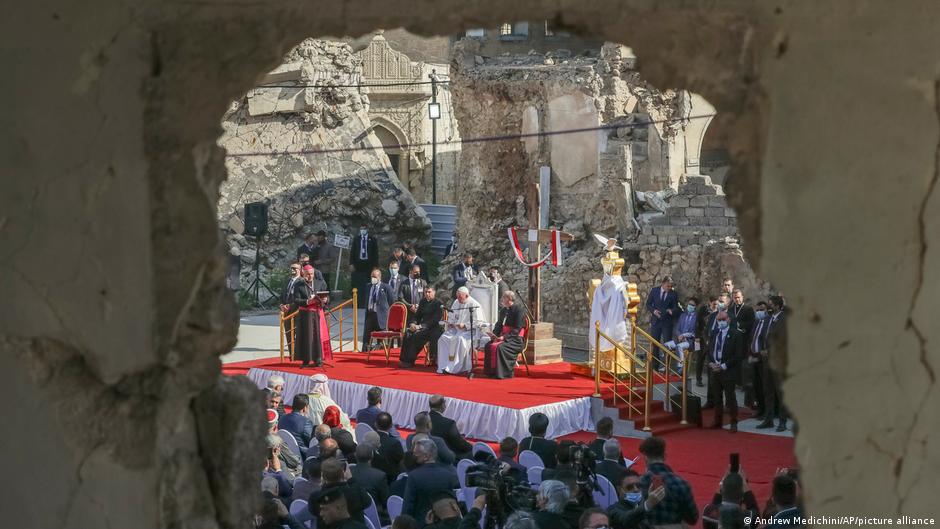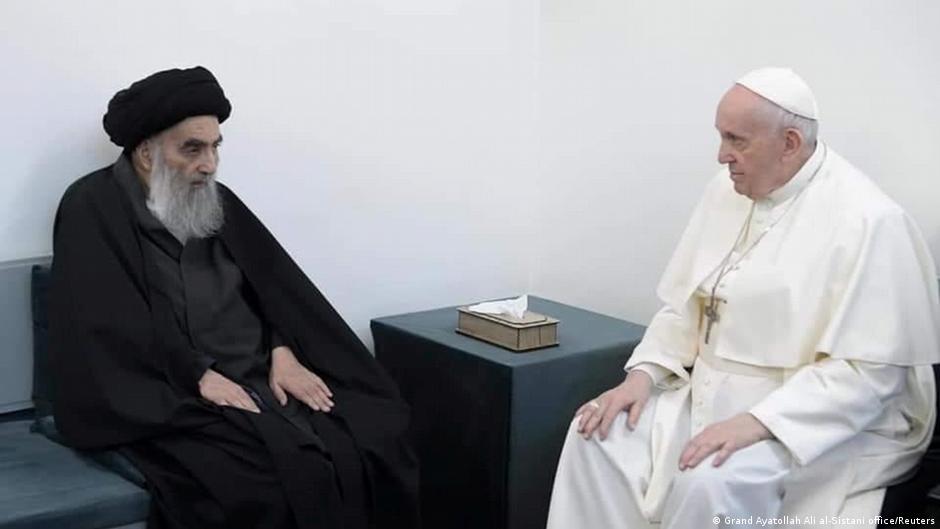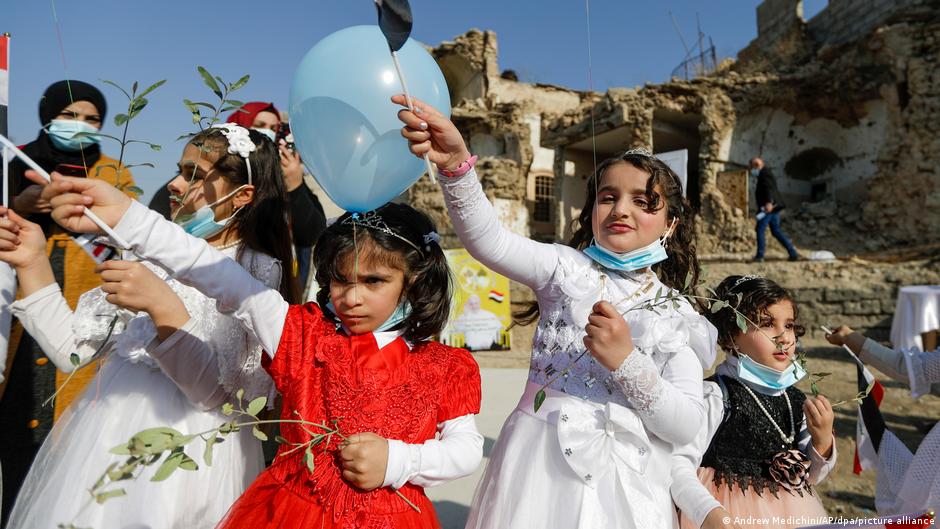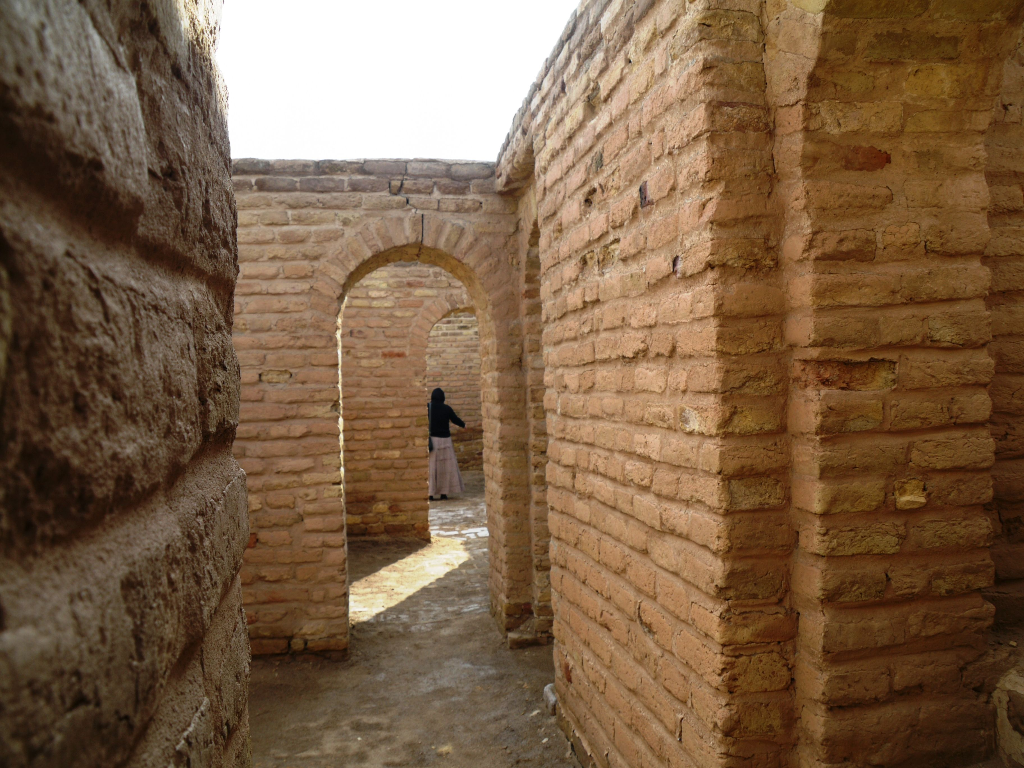The blessing of Pope Francis – "Salaam, salaam, salaam"

The streets leading to the Syriac Catholic church "Our Lady of Salvation" in the Baghdad neighbourhood of Karrada are deserted. Heavily armed soldiers and police check anyone approaching the house of worship. Only those with a special permit are allowed to pass the security personnel.
Members of the congregation have gathered in the courtyard of the church. "I haven’t seen this many in a long time," says Muna with pride. They sit on chairs and almost all of them have white baseball caps bearing the likeness of Pope Francis on their heads. They’re also wearing T-shirts with a message from someone who is for them probably the most high-profile visitors of all time: "We are all brothers!"
Never before had any head of the Catholic church visited Iraq, the ancient historical region of Mesopotamia between the Euphrates and the Tigris. And never before was this visit so important for the people here, who number among the earliest communities of Christendom. "I saw him once in Rome when I went there on a pilgrimage," says Muna. "But it’s a different thing having him come to us."
She’s not allowed to enter the church, she continues. Because of corona, only 100 people have been permitted to go inside. But to be there, to know that she’s close to the Pope, gives her a strength and confidence.
Iraq isn’t just some country that the Pontifex visited for three days. It was probably the most difficult of his eight years in the role. Just two days before his arrival at Baghdad airport, 10 missiles were fired at a military base in the neighbouring province of Anbar.
And in Erbil, in northern Kurdistan, where the Pope held a mass in a soccer stadium on the last day of his trip, the airport had also been attacked with Katyusha rockets two weeks previously.

Although the attacks were all conducted by the Americans, Iraq cannot be described as safe, particularly as the Sunni IS terror militia is again making its presence felt in greater numbers in the north of the country. IS claimed responsibility for the double attack on a market in Baghdad in late January, not far from the church in Karrada. And then came coronavirus and the British mutation that also accelerated infection rates in Iraq. But the Pope decided to come, despite and perhaps also because of the problems facing the nation. He has never been one to shy away from such challenges.
"Baba Francesco" the popstar
His courage was celebrated accordingly. "Baba Francesco" was welcomed like a popstar. A song was composed especially for him. Almost all television broadcast live reports on his pilgrimage in the land of Abraham. The newspapers published special editions. The whole of Iraq was decked out in posters and placards bearing the smiling figure of Francis waving at the people.
Whereas in Baghdad and in the south, stations on the first two days of his trip, curfews were still in place and the streets were largely empty, on the last day in northern Iraq thousands lined the streets of his convoy to wave back at him. Finally, something positive in this nation wracked by war and terror, once the location of Biblical paradise.
That the Syrian-Catholic church on the left bank of the Tigris was the first stop on the Pope’s schedule was not because the Vatican embassy – where he stayed throughout the trip – was diagonally opposite. There was a very special reason. The church with the distinctive tower that resembles a gate with a cross, has become a place of terror for Iraqi Christians. Ten years ago, Al Qaida terrorists attacked the house of worship during mass. The five heavily-armed men took all of those present as hostages and demanded the release of detained jihadists.
Iraqi security forces tried, together with US soldiers, to free the hostages, but the terrorists detonated explosives after forcing their captives to lie on the floor. An indescribable bloodbath ran its course. Sixty-eight worshippers died. The consequences of this massacre were grave. Thousands of Christians left the country, fled to neighbouring countries to then apply to emigrate to the U.S., Canada or Europe. An exodus without parallel.

But just four years later, in 2014, Christians were again targeted by Islamist extremists. This time they went by the name of “Islamic State” or Daesh. The displacement from Mosul, Iraq’s second-largest city at the time and the town of Karakosh 40 kilometres away home to only Christians, again forced thousands to flee. Many found refuge in Kurdish regions, in Erbil and the surrounding area.
The exodus of the Christians
But many left Iraq forever. Since the invasion of the British and the Americans in 2003 and the toppling of Saddam Hussein, three quarters of the nation’s Christians have left. It is estimated that there are now only around 300,000 followers of Christian religions in Iraq. Pope Francis visited all these places of terror and expressed his sympathy. His message was loud and clear: "I am with you, stay here". It remains to be seen whether this will be enough to halt the exodus.
The Pope had a second message for his pilgrimage: interfaith dialogue to foster reconciliation and mutual respect. To promote this message, he travelled to Najaf, two-and-a-half hours by car south of Baghdad, to meet the Shia Grand Ayatollah Ali al-Sistani. His house is located in a narrow alleyway off the main road. Francis covered the last few metres on foot despite having difficulties walking.
He also followed general custom and removed his shoes upon entering the Ayatollah’s house. And so they sat opposite one another in a spartan room, suitably socially distanced with respect to the current pandemic: the most senior dignitary of the Catholic church from Rome and the supreme leader of the Shias in Iraq. This meeting of these two old men, Francis 84, Sistani 90, was crucial for the country’s Christians. They need the protection of the country’s Shia majority. Sistani and Francis also have quite a bit in common. They denounce terror, which has nothing to do with religion and which one must oppose energetically. Both want nothing to do with politics, although they do occasionally put their oar in.

With his plea for a strict division of religion and politics, the Great Ayatollah occupies a completely different position to that of his colleagues in Iran who hold political positions and have unfettered power. But he does sometimes send thundering messages from Najaf to Baghdad, when he calls on politicians to take the demands of the people seriously and fight corruption. This also puts him completely in line with Francis who, immediately upon arrival in Baghdad at the presidential reception, called on the government to pursue the path of democracy and stamp out nepotism and corruption.
The papal visit to their adversary Sistani cannot have pleased the ruling ayatollahs in Iran, because tensions in Iraq between the Shias who are more inclined towards Iran and those who strive for an Iraq that is independent of Iran, are currently growing at an enormous rate.
The future scenario in the "land between the rivers" has for a long time no longer been Shias against Sunnis, but "Iranian Shias" against "Iraqi Shias". This added political spice to Pope Francis’ visit to the home of Sistani.
But his main concern was less the actual meeting with the Shia leader, which lasted just under an hour, and more the interfaith dialogue in the place where the founding father of all three monotheistic religions is supposed to have lived: Abraham, called Ibrahim in the Koran. "It is faith that unites us" said Francis at the start of his visit to Ur, after a reading of Genesis, the start of all life, in the presence of representatives of all religions in Iraq. "The only way we will find peace is by working together". The exchange was very intensive, said the Archbishop of Basra, Habib Jajou, after the meeting. The conclusion was: "Salaam, salaam, salaam!" Peace for a country that has had to endure so much war, terror and suffering.
© Qantara.de 2021
Translated from the German by Nina Coon
